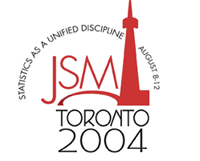
|
Abstract #300985This is the preliminary program for the 2004 Joint Statistical Meetings in Toronto, Canada. Currently included in this program is the "technical" program, schedule of invited, topic contributed, regular contributed and poster sessions; Continuing Education courses (August 7-10, 2004); and Committee and Business Meetings. This on-line program will be updated frequently to reflect the most current revisions. To View the Program: You may choose to view all activities of the program or just parts of it at any one time. All activities are arranged by date and time. |
|
The views expressed here are those of the individual authors and not necessarily those of the ASA or its board, officers, or staff. Back to main JSM 2004 Program page |
|